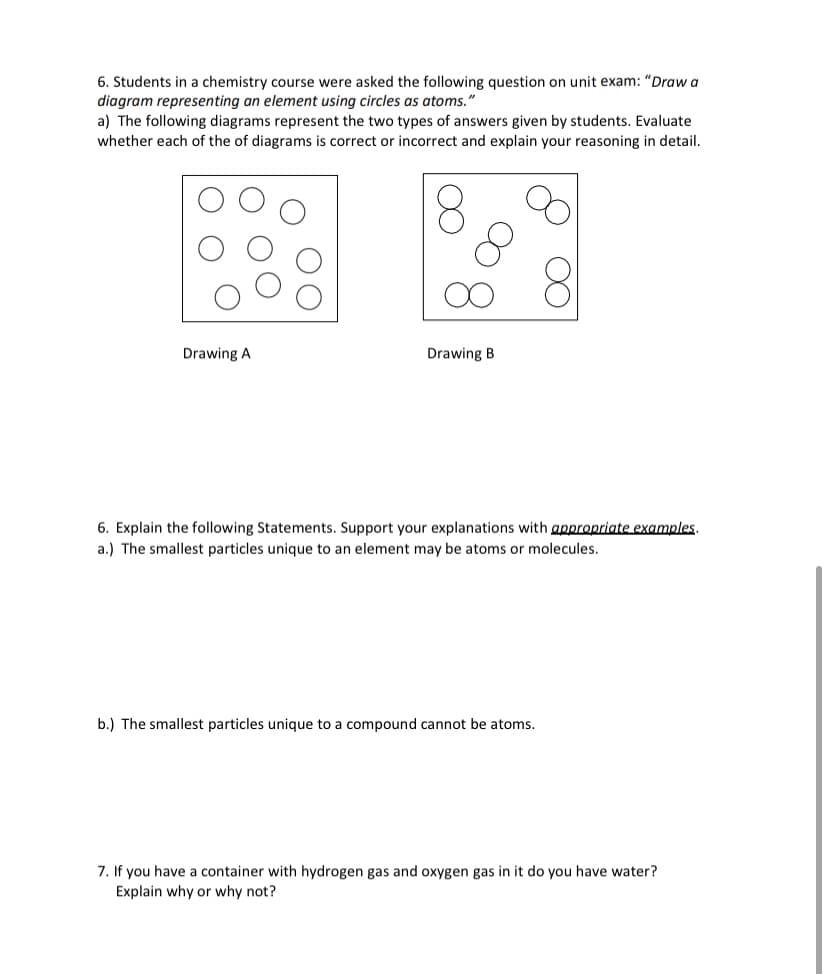6. Students in a chemistry course were asked the following question on unit exam: "Draw a diagram representing an element using circles as atoms." a) The following diagrams represent the two types of answers given by students. Evaluate whether each of the of diagrams is correct or incorrect and explain your reasoning in detail. 8. Drawing A Drawing B 6. Explain the following Statements. Support your explanations with appropriate examples. a.) The smallest particles unique to an element may be atoms or molecules. b.) The smallest particles unique to a compound cannot be atoms. 7. If you have a container with hydrogen gas and oxygen gas in it do you have water? Explain why or why not?
6. Students in a chemistry course were asked the following question on unit exam: "Draw a diagram representing an element using circles as atoms." a) The following diagrams represent the two types of answers given by students. Evaluate whether each of the of diagrams is correct or incorrect and explain your reasoning in detail. 8. Drawing A Drawing B 6. Explain the following Statements. Support your explanations with appropriate examples. a.) The smallest particles unique to an element may be atoms or molecules. b.) The smallest particles unique to a compound cannot be atoms. 7. If you have a container with hydrogen gas and oxygen gas in it do you have water? Explain why or why not?
Introductory Chemistry: An Active Learning Approach
6th Edition
ISBN:9781305079250
Author:Mark S. Cracolice, Ed Peters
Publisher:Mark S. Cracolice, Ed Peters
Chapter5: Atomic Theory : The Nuclear Model Of The Atom
Section: Chapter Questions
Problem 59E
Related questions
Question
Please help me complete this questions

Transcribed Image Text:6. Students in a chemistry course were asked the following question on unit exam: "Draw a
diagram representing an element using circles as atoms."
a) The following diagrams represent the two types of answers given by students. Evaluate
whether each of the of diagrams is correct or incorrect and explain your reasoning in detail.
Drawing A
Drawing B
6. Explain the following Statements. Support your explanations with appropriate examples.
a.) The smallest particles unique to an element may be atoms or molecules.
b.) The smallest particles unique to a compound cannot be atoms.
7. If you have a container with hydrogen gas and oxygen gas in it do you have water?
Explain why or why not?
Expert Solution
This question has been solved!
Explore an expertly crafted, step-by-step solution for a thorough understanding of key concepts.
This is a popular solution!
Trending now
This is a popular solution!
Step by step
Solved in 3 steps

Knowledge Booster
Learn more about
Need a deep-dive on the concept behind this application? Look no further. Learn more about this topic, chemistry and related others by exploring similar questions and additional content below.Recommended textbooks for you

Introductory Chemistry: An Active Learning Approa…
Chemistry
ISBN:
9781305079250
Author:
Mark S. Cracolice, Ed Peters
Publisher:
Cengage Learning


Introductory Chemistry: A Foundation
Chemistry
ISBN:
9781337399425
Author:
Steven S. Zumdahl, Donald J. DeCoste
Publisher:
Cengage Learning

Introductory Chemistry: An Active Learning Approa…
Chemistry
ISBN:
9781305079250
Author:
Mark S. Cracolice, Ed Peters
Publisher:
Cengage Learning


Introductory Chemistry: A Foundation
Chemistry
ISBN:
9781337399425
Author:
Steven S. Zumdahl, Donald J. DeCoste
Publisher:
Cengage Learning

World of Chemistry, 3rd edition
Chemistry
ISBN:
9781133109655
Author:
Steven S. Zumdahl, Susan L. Zumdahl, Donald J. DeCoste
Publisher:
Brooks / Cole / Cengage Learning

Chemistry by OpenStax (2015-05-04)
Chemistry
ISBN:
9781938168390
Author:
Klaus Theopold, Richard H Langley, Paul Flowers, William R. Robinson, Mark Blaser
Publisher:
OpenStax
